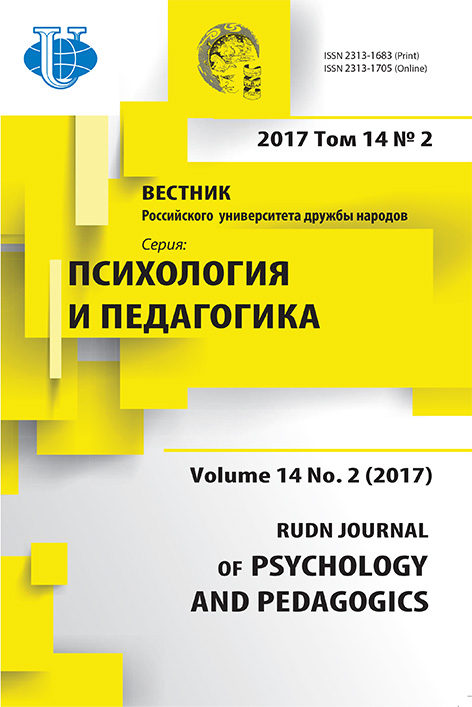VULNERABILITY TO MANIPULATION AND ITS RELATION TO COGNITIVE AND PERSONALITY FEATURES IN ADOLESCENTS
- Authors: Sheĭnov V.P1
-
Affiliations:
- Republican Institute of Higher School
- Issue: Vol 14, No 2 (2017)
- Pages: 167-177
- Section: Articles
- URL: https://journals.rudn.ru/psychology-pedagogics/article/view/15977
- DOI: https://doi.org/10.22363/2313-1683-2017-14-2-167-177
Cite item
Full Text
Abstract
The article suggests an approach to the solution of the interdisciplinary problem of searching for cognitive and personal features of adolescents aged between 14 and 16, subjective to manipulative influence on the part of others. A number of qualities of adolescents that contribute to their vulnerability to manipulation has been revealed, connections have been established between these features. It is shown that the nature of these qualities influence essentially depends on the biological sex and gender of the adolescents. Boys’ vulnerability to manipulation positively correlates with the indicators of their internality, masculinity, androgyny, self-confidence, social courage, predisposition to working with people and to aesthetic, extreme, or economic activities. Girls’ vulnerability to manipulation negatively correlates with the indicators of their internality, masculinity, self-confidence and verbal-logical thinking, but is positively related to their predisposition to working with people. The internality of boys and girls positively correlates with masculinity, self-confidence, social courage; in boys, it also correlates with creative thinking and a predisposition to extreme activities. Masculinity in boys and girls is positively linked to self-confidence, social courage, initiative in social contacts and a predisposition to extreme activities. In boys and girls, self-confidence is positively associated with the creative thinking, with a predisposition to extreme activities and with initiative in social contacts. Boys and girls display positive correlations between self-confidence, social courage, and initiative in socialcontacts. Compared to girls, boys are more vunlerable to manipulation, more internal and self-confident, have greater social courage. Girls have higher averages in visual-figurative and verbal-logical types of thinking, display a tendency to work with people and to aesthetic activity. Boys show higher average indices of abstract-symbolic thinking, a tendency for research, practical and extreme activity. There are signs of feminization of young men.
About the authors
Victor P Sheĭnov
Republican Institute of Higher School
Author for correspondence.
Email: sheinov1@mail.ru
Doctor of Social Sciences, Professor, Professor of the Department of Psychology and Pedagogical Skill of the National Institute of Higher Education (Minsk, Belarus)
Moskovskaya str., 15, Minsk, Republic of Belarus, 220001References
- Anastasi, A. Urbina, S. (2002). Psychological testing. St. Petersburg: Piter. (In Russ.).
- Bem Sex Role Inventory. (2003). In I.S. Kletsina (Ed.). Praktikum po gendernoy psikhologii (pp. 277-280). St. Petersburg, Piter. (In Russ).
- Bratchenko, S.L. (1997). Diagnostika sklonnosti k manipulirovaniyu. Diagnostika lichnostno-razvivayushchego potenciala: metodicheskoe posobie dlya shkol'nyh psihologov (pp. 56-62). Pskov: Izdatel'stvo Pskovskogo oblastnogo instituta povysheniya kvalifikacii rabotnikov obrazovaniya. (In Russ).
- Campbell, D.T. (1960). Recommendations for APA tests standards regarding construct, trait, or discriminant validity. American Psychologist, 15, 546–553. doi: 10.1037/h0048255.
- Dotsenko, E.L. (2004). Psychology manipulation: phenomena and mechanisms of protection. St. Petersburg: Rech. (In Russ).
- Fromm, E. (1992). Man for himself. Minsk: Collegium. (In Russ.).
- Gil'bukh, Yu.Z. (1978). Aktual'nye problemy validizatsii psikhologicheskikh testov. Voprsy psikhologii, (5), 108-118.
- Goodin, R.E. (1980). Manipulatory politics. New Haven: Yale University Press.
- Il'in, E.P. (2008). Differentsial'naya psikhologiya professional'noy deyatel'nosti. St. Petersburg: Piter. (In Russ.).
- Lobanov, A.P., Drozdova, N.V. (2013). Intellekt. Kompetentnost'. Obrazovanie. Minsk, RIVSh Publ.. (In Russ.).
- Nasledov, A.D. (2005). SPSS. Komp'yuternyy analiz dannykh v psikhologii i sotsial'nykh naukakh. St. Petersburg: Piter. (In Russ.).
- Nikiforov, G.S., Dmitrieva, M.A., Snetkov, V.M. (Eds.) (2001). Praktikum po psikhologii menedzhmenta i professional'noy deyatel'nosti. Saint Petersburg: Peter. (In Russ.).
- Panteleev, S.R., Stolin, V.V. (1988) Test-oprosnik sub"ektivnoy lokalizatsii kontrolya. Modifikatsiya shkaly I-E Dzh. Rottera. Praktikum po psikhodiagnostike (pp.131-134). Moscow. (In Russ.).
- Romek, V.G. (1998). Testy uverennosti v sebe. Prakticheskaya psikhodianostika i psikhologicheskoe konsul'tirovanie (pp. 87-108). Rostov-on-Don: Irbis. (In Russ).
- Ryumshina, L.I. (2000). Empiricheskoe izuchenie stilei povedeniya pedagogov. Voprosy psikhologii, (1), 142-150. (In Russ.).
- Ryumshina L.I. (2003). Psikhologiya manipulirovaniya lyud'mi (cennostno-smyslovoi aspekt). Rostov-on-Don. (In Russ.).
- Sheĭnov V.P. (2011). Psikhologiya manipulirovaniya. 3rd ed. Moscow: AST. (In Russ.).
- Sheĭnov V.P. (2012). Razrabotka oprosnika dlya otsenki stepeni nezashchishchennosti individa ot manipulyativnykh vozdeystviy. Voprosy psikhologii, (4), 147-154. (In Russ.).
- Sheĭnov V.P. (2013). Psikhologicheskoe vliyanie. 6th ed. Moscow: AST. (In Russ.).
- Sheĭnov, V.P. (2016). Self-Reliance and Psychological Gender. Systems Psychology and Sociology, (3), 54-59. (In Russ/).
- Sheĭnov, V.P. (2017). Disadvantaged students from manipulation and psychological gender, locus of control and self-confidence. Systems Psychology and Sociology, 1. (In Russ).
- Shostrom E. (1992). Anti-Karnegi ili Chelovek-manipulyator. Minsk: TPTs Polifakt Publ. (In Russ.)
- Shostrom E. (2002). Man the Manipulator. The inner journey from manipulation to actualization. Moscow: Dubl' –V. (In Russ.).
















